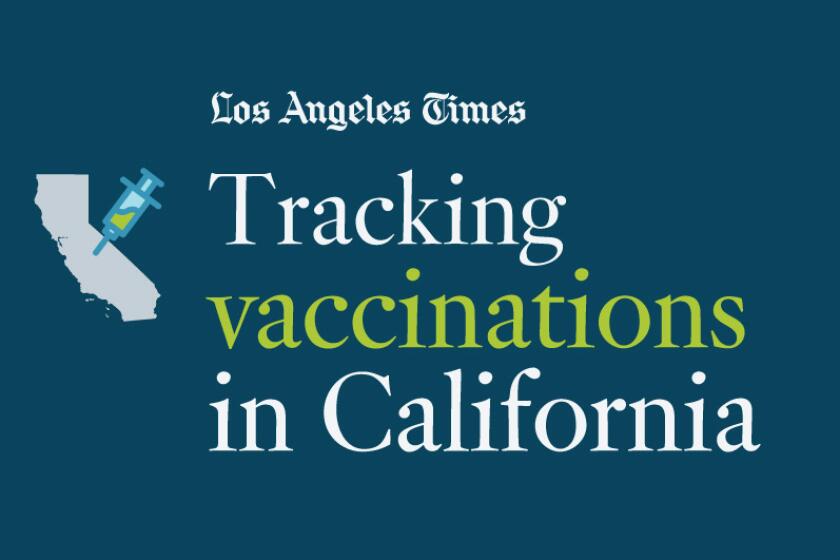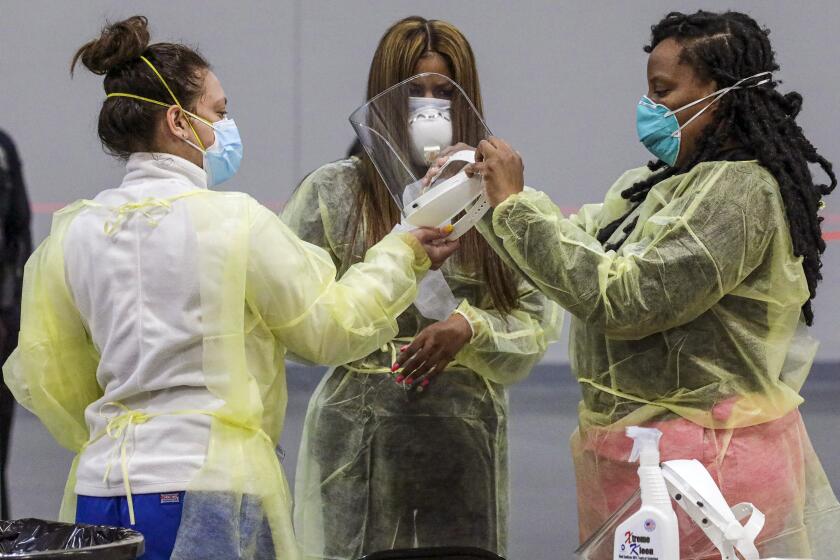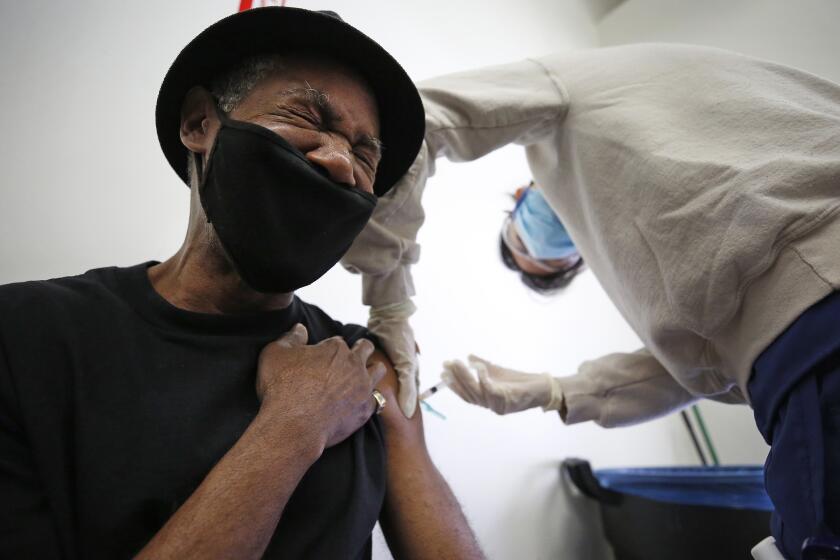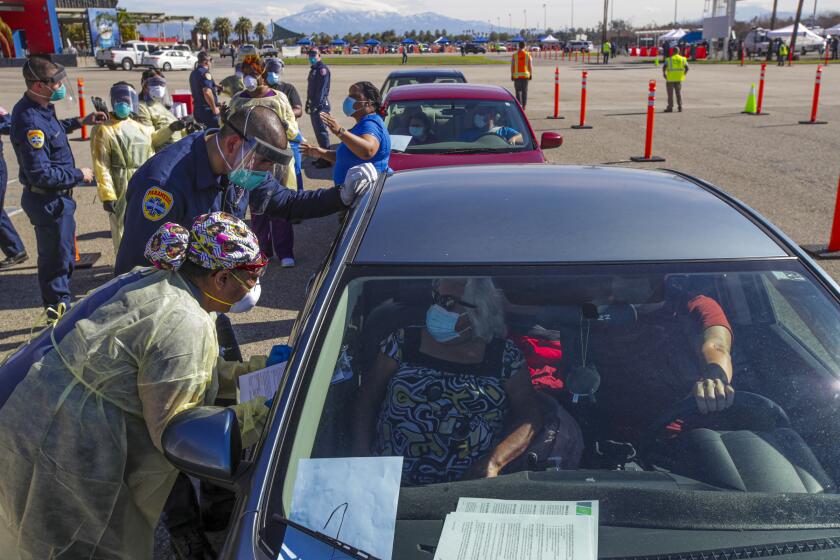First doses of COVID-19 vaccine have become limited in California. When will that change?

- Share via
California counties are finally getting more COVID-19 vaccines.
Yet despite that, securing a first dose is getting more difficult. That’s because large amounts of the new supplies are being reserved for people needing their second dose — leaving fewer shots for everyone else who’s eligible.
Here are some things you need to know:
Experts say about most Americans will need to be vaccinated to bring the coronavirus pandemic under control. Track California’s progress toward that goal.
Where do we stand with vaccine shipments?
Los Angeles County, the nation’s most populous, has seen its vaccine shipments seesaw wildly over the past month, making it difficult for officials to accurately peg the amount of supplies they’ll have. About 193,950 doses arrived the week of Jan. 11, but 168,575 were delivered the following week and only 137,725 arrived the week after that.
Most recently, the county received 184,625 doses — a number expected to climb this week to more than 218,000.
L.A. is far from alone in singing the vaccine blues. Officials throughout California have lamented the limited and variable vaccine shipments they’ve received, saying they have the capability to provide significantly more shots.
“We can’t move fast enough,” Gov. Gavin Newsom said Monday. “We are sober and mindful of the scarcity that is the number of available vaccines.”
Officials say they will be able to provide more first doses when they start getting larger, more sustainable shipments.
Wondering about how to get your second dose appointment? You’re not alone. L.A. County has updated its guidance again. Here’s what you need to know.
How much of the vaccine is reserved for second doses?
L.A. County Public Health Director Barbara Ferrer said Monday that about 55% of the doses expected this week will be needed for second shots — which are required a few weeks after people initially roll up their sleeves.
County officials have already said they will be limited to administering second doses for the rest of the week, starting Tuesday, at a handful of major vaccination sites: the Fairplex in Pomona, the Forum in Inglewood, the county Office of Education in Downey, Cal State Northridge, El Sereno, Six Flags Magic Mountain in Valencia and Balboa Sports Complex in Encino.
While the county is committed to providing second doses as close to the recommend interval as possible — three weeks for Pfizer-BioNTech and four weeks for Moderna — Ferrer acknowledged that “it is hard to manage a vaccination program with so much variability in the weekly allocations.”
Dr. Paul Simon, chief science officer for the L.A. County Department of Public Health, said last week that only a very limited number of people will be able to receive their first doses this week at the county’s five mega-PODs, or mass points of distribution.
“We’re just struggling with the supply, the limited supply, and feeling an obligation to make sure that people that had a first dose are able to get their second dose,” he said during a briefing.
“But we know, just based on the numbers, next week at least in our sites, beyond Monday, we really have to stick with the second doses. When we get to the following week, it may be a slightly different story if we are able to get a larger supply of a vaccine. But we’ll have to wait and see.”
Who gets California’s COVID-19 vaccine? A ‘Sophie’s Choice’ moment for many in need.
Is this the right approach?
With the shortage, there has been considerable public discussion about whether officials should shift their focus to giving first doses to as many people as possible, rather than earmarking precious supplies to ensure on-time administration of a second dose.
The thinking goes that even one shot provides some level of protection against COVID-19. Officials have said if it’s not feasible to adhere to the recommended schedule, then in extremely rare circumstances, administering the second dose within six weeks of the first may be done.
But federal officials are in agreement that the second dose should be delivered as close to the recommended timing as possible.
Dr. Anthony Fauci, the U.S. government’s top infectious diseases expert, said Monday that the two-dose regimen unlocks the full benefits of the vaccine. While first dose provides “some degree of protection,” the second dose multiplies the level of protection by a factor of 10.
That’s important not only “because of the height of the response and the potency of the response, but as you get to that level of antibody, you get a greater breadth of response,” he said during a White House COVID-19 Response Team briefing. “And by breadth of response, we mean it covers not only the ... currently circulating virus, but also the variants that we see circulating.”
The findings raised new concerns about inequity in the troubled rollout of vaccines for those 65 and older and add pressure on county leaders to do a better job of getting communities of color immunized.
What is the latest on eligibility rules now?
Right now, California is reserving doses only for people 65 and older as well as medical workers and first responders.
It will take months to vaccinate those groups, but there is much debate about who goes next.
Labor unions, disability rights groups, teachers and others are all making their case. The state’s 60-member vaccine advisory committee has spent weeks discussing the matter and could make a decision this week.
The state is working on logistics for how residents with disabilities and underlying health conditions could be prioritized for the vaccine next.
But on Monday, Newsom indicated that details were still being hashed out and that he and Dr. Mark Ghaly, secretary of the state’s Health and Human Services Department, were committed to figuring out a plan by the end of the week.
Last month, Newsom said that after the state had vaccinated individuals 65 and older and healthcare workers, the rollout plan would shift to an age-based eligibility approach — an announcement that lacked clarity and has caused widespread confusion. On Monday, Newsom said the age-based plan was in reference to adults 65 and older qualifying for the vaccine.
Focusing on older people, the disabled and others at higher risk of becoming critically ill from the coronavirus has the potential to save many lives. Reserving doses for essential workers would also help slow the spread of the disease. And moving educators to a higher position could make teachers willing to return to campus for in-person instruction.
During an advisory meeting last week, members from the smaller group responsible for drafting the state’s vaccine guidelines said that new recommendations would be presented following meetings Friday among the working group and a new state task force.
The state task force, composed of members from the departments of Aging, Disability Services and Health and Human Services, was recently launched to sort out the logistics for how residents with disabilities and underlying health conditions could be prioritized next.
State guidelines provide local officials with some discretion over those to prioritize next — and those options include teachers. As a result, some local health agencies have begun to accept appointments to vaccinate teachers and other front-line educators, including Riverside County and the city of Long Beach — which has its own local public health department independent from L.A. County.
More to Read
Sign up for Essential California
The most important California stories and recommendations in your inbox every morning.
You may occasionally receive promotional content from the Los Angeles Times.





















